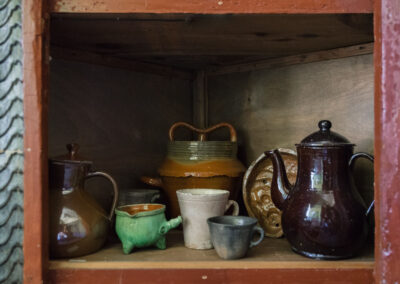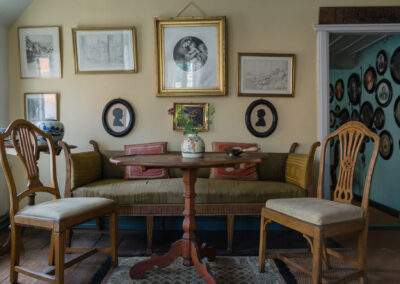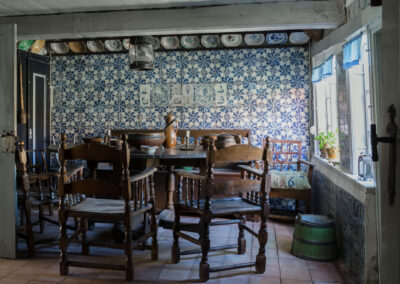Hammerich’s House
Open 3 June–19 October 2024
If you are fortunate to be on Ærø during the season, be sure to visit Hammerich’s House in Ærøskøbing.
Here you will find low-ceilinged rooms, as well as nooks and crannies in abundance, but this is also where you will find the story of the sculptor Gunnar Hammerich and his love for the old town.
Practical information
How much does it cost? Where is Hammerich’s House located? Find the answers on this page.
Opening hours Hammerich's House
Hammerich’s House is open 3 June -19 October 2024.
Monday–Saturday 11.00 am–2.00 pm.
Summer period, 29 June–31 August:
Hammerich’s House is open Monday–Sunday 11.00 am–2.00 pm.
Admission
| Adults | DKK 50 |
| Children (0-17) | Free |
| Group rate (min. 10 persons) | DKK 40 |
| Combines ticket | DKK 100* |
*Includes admission to Ærø Museum and Hammerich’s House
We reserve the right to make changes.
Combined ticket
A combined ticket includes admission to both Ærø Museum and Hammerich’s House.
Combined tickets can be purchased from the ticket office at Ærø Museum, Brogade 3–5 in Ærøskøbing.
Group discount
For groups with a minimum of 10 paying guests, the price is DKK 40 per person. The group discount cannot be combined with other discount schemes.
We would ask groups of more than 10 to contact us in advance. This applies both if you are coming to look round yourself or if you would like a guided tour. This allows us to ensure that you have the best possible experience.
Free admission
Children and young people below the age of 18 have free admission to the museum.
Companions of disabled persons have free admission on production of their companion card.
Bus drivers and travel guides visiting the museum with a large group have free admission.
Pupils, teachers and students visiting the museum for educational purposes have free admission.
Payment
If you have cash or MobilePay you can buy tickets at Hammerich’s House.
If you wish to pay by credit card, you can buy tickets for Hammerich’s House at the ticket office at Ærø Museum, Brogade 3–5 in Ærøskøbing. This is a one minute walk from Hammerich’s House.
Contact the museum
Please contact Ærø Museum:
By phone +45 62 52 29 50 or by e-mail: info.aeroe@museumsydfyn.dk
How to find us
Hammerichs Hus, Gyden 22, 5970 Ærøskøbing
Hammerich’s House, Gyden 22, DK-5970 Ærøskøbing
Hammerich’s House is around 5 minutes on foot from the ferry berth (to and from Svendborg) and the bus stop (to and from Marstal/Søby) in Ærøskøbing. Bus travel is free on Ærø.
Parking
Hammerich’s House is located right in the centre of Ærøskøbing’s narrow streets.
We therefore recommend that anyone arriving by car should park at the harbour or in Pilebækken. From there, it takes around 5 minutes on foot to reach the museum.
Accessibility
Admission
Companions of disabled persons have free admission on production of their companion card.
Access
Hammerich’s House has many small rooms and steep staircases. The house is therefore not suitable for people who have trouble walking and people in wheelchairs.
Smoking
Smoking is not permitted in Hammerich’s House.
Photography
You are welcome to take photographs in the museum for private use.
For professional photography, you must contact the museum in advance by e-mail at: info.aeroe@museumsydfyn.dk
Groups
We offer guided tours in English to private groups, associations, company events and anyone else wishing to experience the museum. A guided tour lasts for approx. 1 hour.
As the rooms in Hammerich’s House are small, the number of people on a guided tour is limited to 15. On the other hand, there is no minimum number. For example, we would be happy to arrange a guided tour for a group of, for example, five people.
Please contact us in good time, ideally a minimum of 14 days before your visit. Please call on +45 6252 2950.
A young man arrives in town
Gunnar Hammerich (1893–1977) took the ferry to Ærø for the first time in 1913. At the time, he was an apprentice merchant with Baagøe & Riber in Svendborg Harbour, but his dream was to paint.
At a time when artists were leaving the big cities to look for original, unspoiled spots on the map, Ærø was one of the exotic locations that was ‘discovered’.
Around the time of the First World War, a small colony of permanently resident artists was established, while others found their way here during the summer. Gunnar Hammerich was one of these, before he bought a cheap house in Ærøskøbing in 1916.
With Gunnar Hammerich as the attentive host, the house on the corner of Gyden and Brogade became a gathering place for painters and authors, jovial souls from the town’s middle classes, and friends and acquaintances from Copenhagen.
A town in a state of change
Originally, Hammerich’s House consisted of three houses. Gunnar Hammerich bought the first one in 1916, but in the following years the neighbouring houses came up for sale and he combined them all into one.
House prices at the time were very low in Ærøskøbing, as the town was in the process of changing. The long seafaring traditions of the people of Ærøskøbing belonged to the past. Steamships outcompeted the old sailing ships, and in Ærøskøbing it was becoming socially acceptable to choose other, less hazardous occupations than seafaring. However, this was not without consequences for the life of the town.
After the First World War, the town almost stagnated. More and more young people chose to move from Ærø. The result of this was an ageing population as fewer children were being born. At the same time, massive urban development in the country’s provincial towns led to a focus on the value of the old houses and the need to ‘protect’ them before it was too late.
This work began with Denmark’s first building protection legislation in 1918, and a mere year later around 30 houses received protected status in Ærøskøbing, including “Hammerich’s House”.
One of the first holiday homes
The massive urban development elsewhere in the country led to a yearning for the old days – a yearning that Ærøskøbing was able to satisfy. Between the two World Wars, the tourist association marketed the town as a marvellous “Sleeping Beauty town” and gradually conservation and tourism came to go hand in hand.
Today, Hammerich’s House epitomises the development of the town after the First World War. The house was built in 1803, and before Gunnar Hammerich moved in it had been home to a mariner, a tailor, a mason, the widow of a customs inspector, and a sailmaker.
However, whereas the previous owners had been permanently resident, Gunnar Hammerich used it only during the summer period. Hammerich’s House is therefore one of Ærøskøbing’s first holiday homes.
Sculptor from the Royal Danish Academy of Fine Arts
Gunnar Hammerich was raised in Østerbro in Copenhagen. His father, engineer and Councillor of State Holger Aaggaard Hammerich (1845–1915), was a member of the Danish Parliament for the Conservative Party (Højre), while his mother Pauline Mølmark (1854–1927) was a doctor’s daughter from Svendborg.
His parents were keen for him to have a sensible education. It was only after completing the one-year course at Merchant School and being an apprentice at Baagøe & Riber that he was allowed to apply to the School of Sculpture at the Royal Danish Academy of Fine Arts.
He was admitted in 1916, the same year as he bought the house in Ærøskøbing, and started at Charlottenborg in 1918.
Hammerich was a collector
As well as being a meeting place and a holiday home, Hammerich’s House was also the place where Gunnar Hammerich developed as a collector.
He collected items that looked good in the house and that had narrative value and local character, particularly from Ærø and Southern Jutland. At the same time, he was fascinated by hand-made items – “right from the smoothest little things in wood, clay and metal to the exquisite creations in porcelain, glass and every metal.”
In the house, you can see the record of “The Essentials”, where Gunnar Hammerich meticulously noted the origins of the items and added detailed drawings.
Hammerich’s House as a museum
In 1967, Gunnar Hammerich transferred his house to Ærøskøbing Municipality. The aim was to ensure that the house and collection were preserved for the future. The agreement states that ‘… the collection shall be maintained as it is now and as it is found.’ The more than 2,500 items in the house therefore still remain where Gunnar Hammerich decided they would be.
Hammerich’s House has been part of Ærø Museum since 1990, and is almost a museum item in itself.
As a state-recognised museum, we are under obligation to preserve the house and the collection for the future, and this places a number of restrictions on the use of the house. In order to avoid excessive wear and tear, we invite visitors inside only during a limited period in the summer months.



